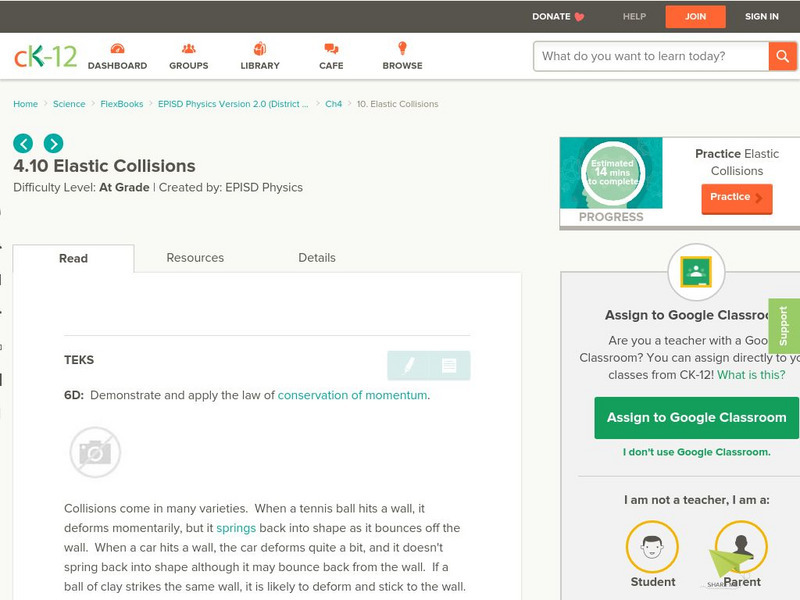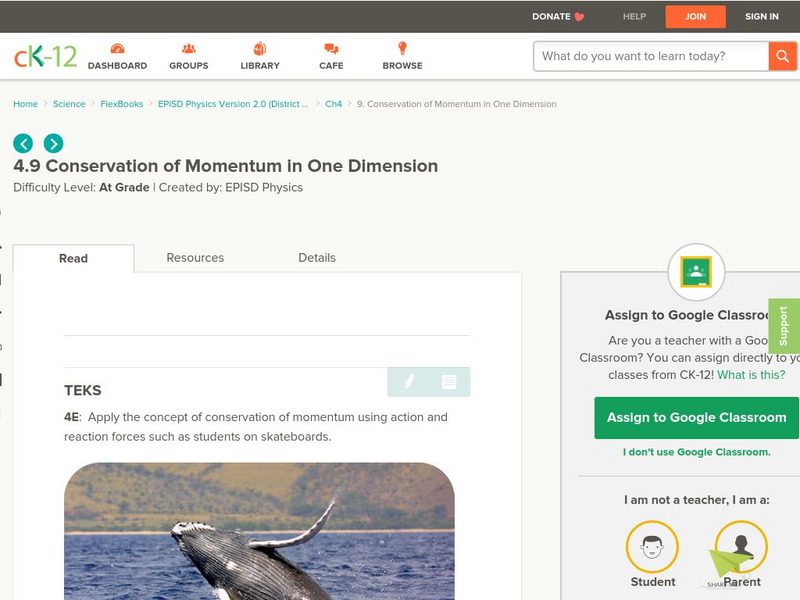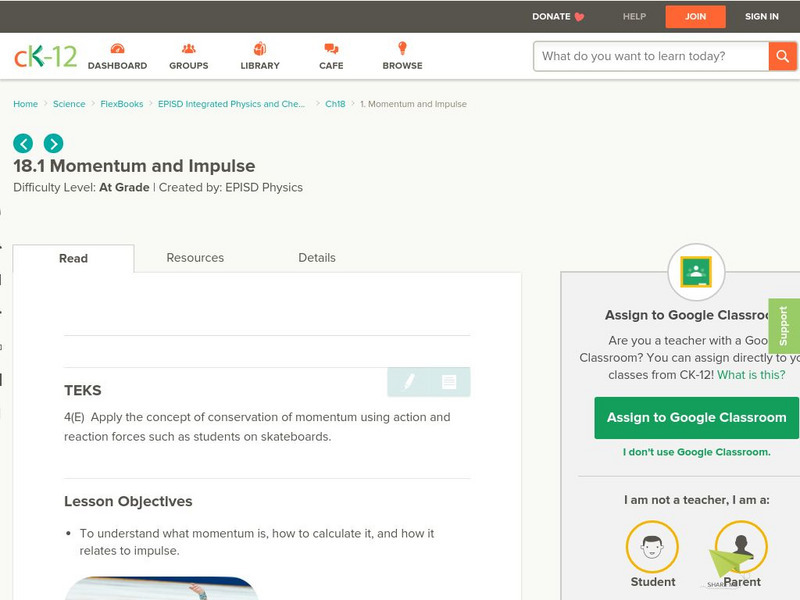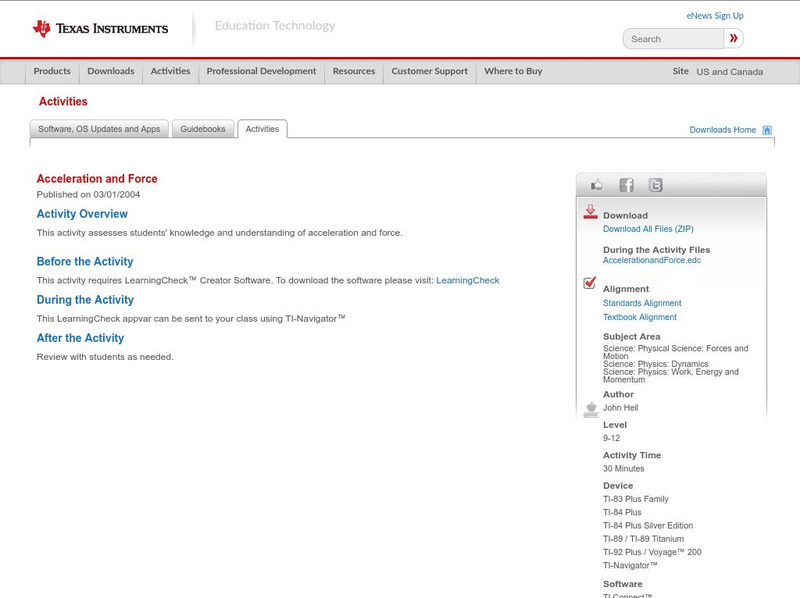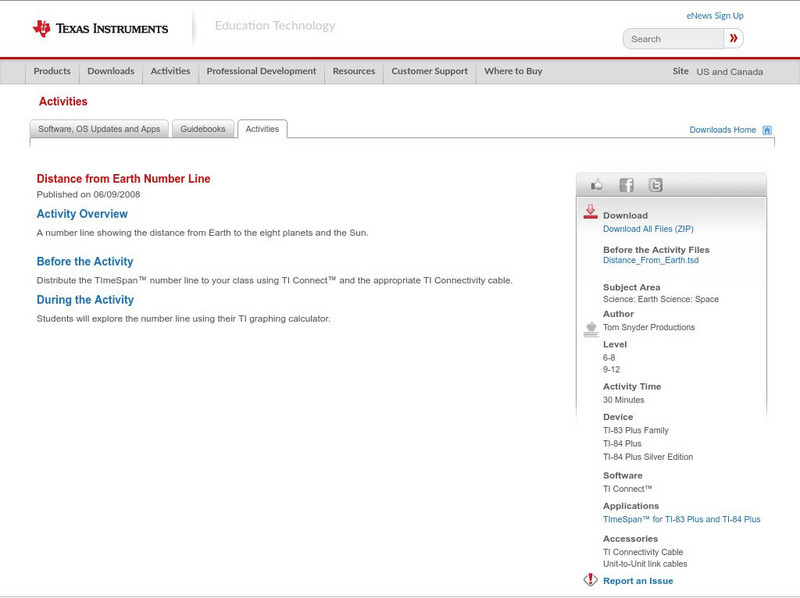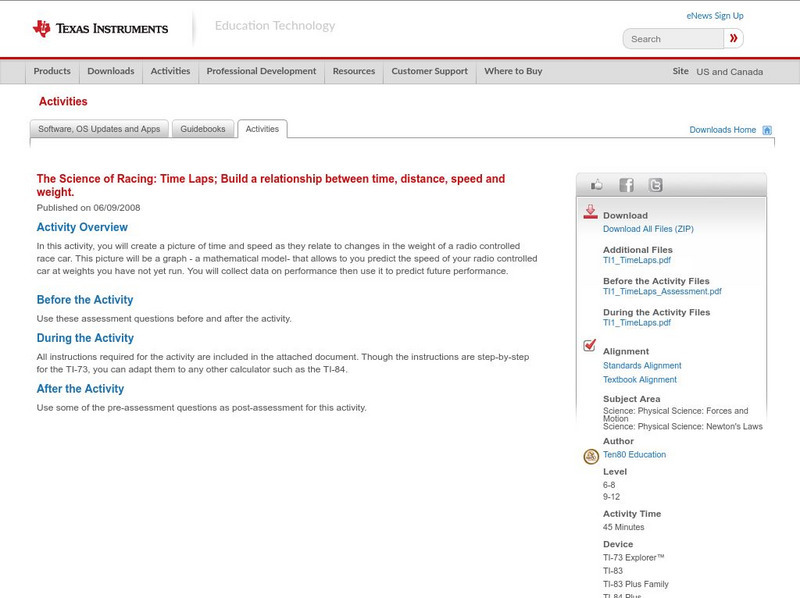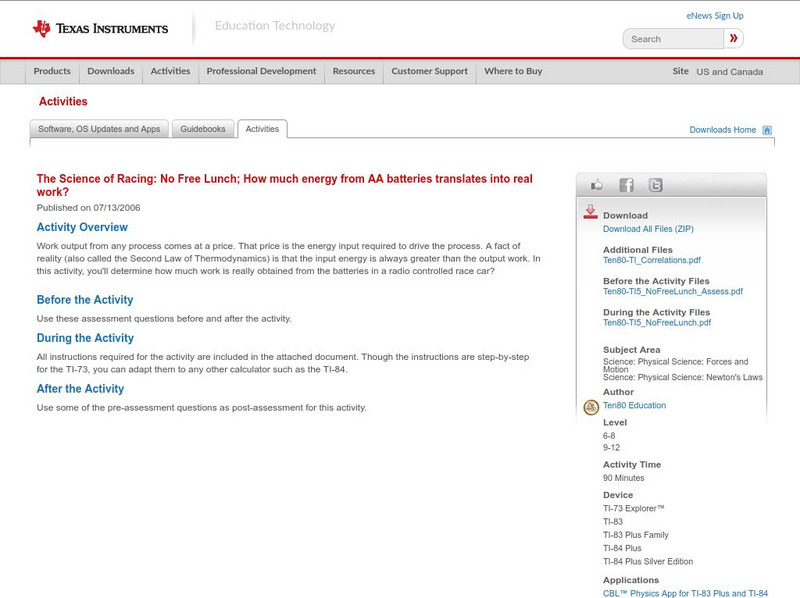CK-12 Foundation
Ck 12: Elastic Collisions
[Free Registration/Login may be required to access all resource tools.] In this online tutorial students are asked to demonstrate and apply the law of conservation of momentum.
CK-12 Foundation
Ck 12: Impulse
[Free Registration/Login may be required to access all resource tools.] In this online tutorial students will be asked to calculate the impulse applied to a physical system.
CK-12 Foundation
Ck 12: Conservation of Momentum in One Dimension
[Free Registration/Login may be required to access all resource tools.] In this online lesson students will apply the concept of conservation of momentum using action and reaction forces.
CK-12 Foundation
Ck 12: Momentum and Impulse
[Free Registration/Login may be required to access all resource tools.] Students investigate what momentum is, how to calculate it, and how it relates to impulse.
Massachusetts Institute of Technology
Mit: Open Course Ware: Impulse and Momentum
Students explore impulse and momentum. Some topics examined in the activities are collisions, impulse, Newton's laws, and momentum. The resource consists of lecture notes, practice problems, and exam questions. Practice problems and exam...
Georgia State University
Georgia State University: Hyper Physics: Relativistic Momentum
A clear (as these things go) presentation of the calculation of relativistic momentum. Given with a handy calculator that even calculates the % error. The site goes on to Momentum of a Photon, and to Relativistic Energy in Terms of...
Georgia State University
Georgia State University: Hyper Physics: Relativistic Energy
A mathematically understandable presentation of relativistic energy. Parts include Relativistic Energy, Rest Mass Energy, Conservation of Energy, Pair Production, Relativistic Kinetic Energy, and even Kinetic Energy. A couple of...
Texas Instruments
Texas Instruments: The Science of Racing: Newton Knew
For race car engineers, F = m a, is the backbone of the vast majority of calculations. The selection of gear ratios is one example. Investigate and create a mathematical model for the relationship between force, speed, mass, distance and...
Texas Instruments
Texas Instruments: Forces
This activity is designed to assess the comprehension of concepts related to various forces.
Texas Instruments
Texas Instruments: Acceleration and Force
This activity assesses students' knowledge and understanding of acceleration and force.
Texas Instruments
Texas Instruments: Impulse and Momentum
This activity assesses students' knowledge and understanding of impulse and momentum.
Texas Instruments
Texas Instruments: The Science of Racing: Hitting the Mark
Since running a race car is VERY expensive, race engineers know a great deal about how speed, time and distance relate. In this activity, you will investigate the relationship between distance traveled, speed and elapsed time. You will...
Texas Instruments
Texas Instruments: Distance From Earth Time Line
A number line showing the distance from Earth to the eight planets and the Sun.
Texas Instruments
Texas Instruments: Circular Motion
This activity will examine the student's comprehension of the basic rotational motion concepts in the field of physics.
Texas Instruments
Texas Instruments: The Science of Racing
Turning the corners is the limiting process for racing cars. Going straight is simply about speed, but making the turns faster than other cars is a real challenge. In this activity, we ask how does weight balance affect the turn radius...
Texas Instruments
Texas Instruments: An Inclined Plane
In this activity, Students can use a Force Sensor to measure the force needed to lift an object and the force needed to pull the same object up an inclined plane. They will also calculate work done and efficiency and make conclusions.
Texas Instruments
Texas Instruments: Work, Power and Energy
This activity assesses students' knowledge and understanding of work, power, and energy.
Texas Instruments
Texas Instruments: The Science of Racing: Time Laps
In this activity, you will create a picture of time and speed as they relate to changes in the weight of a radio controlled race car. This picture will be a graph - a mathematical model- that allows to you predict the speed of your radio...
Texas Instruments
Texas Instruments: The Science of Racing: How Much Energy From Aa Batteries
Work output from any process comes at a price. That price is the energy input required to drive the process. A fact of reality (also called the Second Law of Thermodynamics) is that the input energy is always greater than the output...
Science Education Resource Center at Carleton College
Serc:investigating Friction:investigate How the Force of Friction Opposes Motion
For this investigation, students will learn that speed, velocity, and changes in velocity are the result of the action of forces on objects such as friction. They will be able to explain how the force of friction opposes motion by...
Science Education Resource Center at Carleton College
Serc: Newton's Second: Having a Ball With Motion
Students will create a gravity ball launcher to demonstrate their understanding of mass, force, momentum, and motion. The students will use critical thinking, measurement, and observation and analysis of data to make changes and improve...
Science Education Resource Center at Carleton College
Serc: Egg Drop
In this physics lab, students build a container to safely deliver two eggs from the top of the school. Students calculate average velocity, acceleration, momentum, and the amount of force as it hits the ground. If their egg breaks, they...
Science Education Resource Center at Carleton College
Serc: Com Padre: Will the Egg Break?
In this activity, students investigate why an egg does not break when thrown at a hanging sheet, but does when thrown at a wall. They will learn about momentum, and its applications.
Science Education Resource Center at Carleton College
Serc: Angular Momentum Experiment
After reading about the historical development of concepts of conserved motion, students are directed to a series of activities to gain a better understanding of momentum, conservation of momenta, angular momentum, and conservation of...


